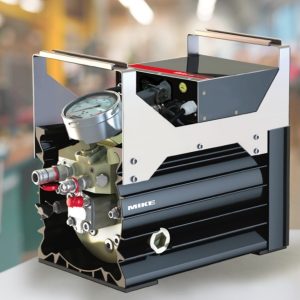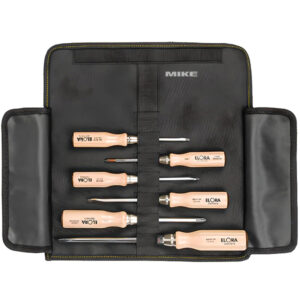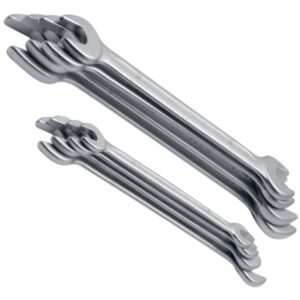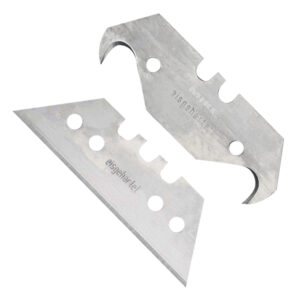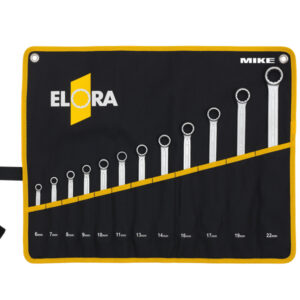Hydraulic pumps working at 700 bar specially for tools. First, it’s important to understand that hydraulic pressure is typically measured in bar or psi (pounds per square inch). A bar is a metric unit of pressure equal to approximately 14.5 psi.
A hydraulic pump is a device that converts mechanical energy into hydraulic energy by creating flow and pressure within a hydraulic system. The pump works by drawing hydraulic fluid (typically oil) from a reservoir and forcing it through a series of valves and into a hydraulic cylinder or motor.
In the case of a two-stage hydraulic pump, the pump has two zones or stages of operation. The first stage is designed to provide high volume flow at low pressure, while the second stage provides high pressure at a lower flow rate. This two-stage design allows the pump to efficiently generate high pressure while still maintaining good flow characteristics.
A hydraulic pump operating at 700 bar is capable of generating extremely high pressure within a hydraulic system. This level of pressure is typically used in applications where a high force or torque is required, such as in heavy machinery, construction equipment, and hydraulic presses.
It’s also important to note that working with hydraulic systems at high pressures can be dangerous if proper safety precautions are not taken. It’s important to use appropriate personal protective equipment (PPE) and follow all safety guidelines when working with hydraulic systems at high pressures.
When working with high-pressure hydraulic systems, it’s important to ensure that all components are properly rated for the maximum pressure of the system. This includes the pump, hoses, fittings, and other hydraulic components. Any weak or damaged components can fail under pressure, leading to leaks or even catastrophic failures.
To ensure the safe operation of a hydraulic pump operating at 700 bar, it’s important to follow all manufacturer guidelines and maintenance procedures. This includes regular inspection and testing of all components, as well as proper storage and handling of hydraulic fluid.
In terms of the pump itself, there are a few different types of hydraulic pumps that can operate at high pressures. These include gear pumps, vane pumps, and piston pumps. Each type of pump has its own advantages and disadvantages, and the choice of pump will depend on the specific application requirements.
Hydraulic pumps operating at 700 bar are powerful tools that can be used in a wide range of industrial and maintenance applications. However, it’s important to use these pumps safely and responsibly to prevent accidents or equipment failures.
Hand pumps working at 700 bar
A hand pump that operates at 700 bar is a type of hydraulic pump that is manually operated by hand to generate high pressure within a hydraulic system. These pumps are typically used in applications where no compressed air or electricity is available, or where portability is important.
Hand pumps that operate at 700 bar are often designed to work with single or double-acting hydraulic cylinders, which are used to move and position heavy loads or perform other tasks that require high force or torque. The pump generates hydraulic pressure by manually pumping a lever or handle, which forces hydraulic fluid through the hydraulic system.
Hand pumps that operate at 700 bar may have a two-stage design, as I mentioned earlier, or they may be single-stage pumps that generate high pressure directly. The choice of pump will depend on the specific application requirements.
Hand pumps that operate at 700 bar are typically made from lightweight aluminum or heavy-duty steel, depending on the application requirements. Aluminum pumps are lightweight and easy to transport, while steel pumps are more durable and can handle higher loads and pressures.
One important consideration when working with hand pumps that operate at 700 bar is the amount of force required to generate the necessary pressure. Pumping a lever or handle to generate high pressure can be physically demanding, especially if the pump is being used for an extended period of time. Some hand pumps may be equipped with ergonomic handles or other features to make them easier to use.
It’s also important to note that hand pumps that operate at 700 bar can be dangerous if not used properly. It’s important to follow all manufacturer guidelines and safety procedures when working with hydraulic systems at high pressures, including the use of appropriate PPE and regular inspection and maintenance of all components.
Electric-driven hydraulic pumps
An electric-driven hydraulic pump is a type of hydraulic pump that is powered by an electric motor. These pumps are typically used in applications where a continuous and reliable source of hydraulic power is required. Electric-driven pumps are particularly useful in industrial applications where compressed air or manual pumping is not practical or efficient.
Electric-driven hydraulic pumps are often designed with various types of motors, including AC or DC motors, to provide different levels of power and speed. The motor drives a hydraulic pump, which generates hydraulic pressure by forcing hydraulic fluid through the system. The pump may be a gear pump, vane pump, or piston pump, depending on the specific application requirements.
One of the main advantages of electric-driven hydraulic pumps is that they can be operated remotely, using electrical controls or remote switches. This allows the operator to control the flow and pressure of the hydraulic system from a safe distance. Electric-driven pumps are also capable of generating consistent and accurate pressure, which is important in applications where precise control is required.
Another advantage of electric-driven hydraulic pumps is that they can be more efficient than other types of pumps, such as manual or pneumatic pumps. This is because electric motors can be designed to run continuously, providing a steady stream of power to the pump. In contrast, manual or pneumatic pumps require human or compressed air power, which can fluctuate in intensity and result in less consistent output.
However, one potential drawback of electric-driven hydraulic pumps is that they require a source of electricity to operate. This means that they may not be suitable for applications where electricity is not available or where portability is important. Additionally, electric-driven pumps may require more maintenance than other types of pumps, such as manual pumps, due to the complexity of the electrical and hydraulic systems.
What is about air driven hydraulic pump working at 700 bar?
An air-driven hydraulic pump is a type of hydraulic pump that uses compressed air to generate hydraulic pressure. These pumps are commonly used in applications where electric or manual pumps are not practical, such as in remote locations or hazardous environments.
Pumps that operate at 700 bar (or approximately 10,000 psi) are considered high-pressure pumps. They are typically used in applications that require high force or where precision is critical. Some examples of applications that may require a pump operating at 700 bar include high-pressure testing, hydraulic presses, and hydraulic jacks.
When using an air-driven hydraulic pump at 700 bar, it is important to ensure that the pump is designed and rated for this high-pressure operation. The pump should also be properly maintained and inspected to ensure that it is operating safely and efficiently. Additionally, it is important to follow all recommended safety procedures and guidelines when working with high-pressure hydraulic systems to prevent accidents or injuries.
Air-driven hydraulic pumps typically work by using compressed air to drive a piston or diaphragm, which then pressurizes hydraulic fluid in the pump’s reservoir. This pressurized fluid is then delivered to the hydraulic system through a hose or other conduit. The amount of pressure generated by the pump depends on various factors such as the size of the pump, the air pressure supplied, and the design of the pump’s hydraulic circuit.
When operating a pump at 700 bar, it is important to consider the potential hazards associated with high-pressure hydraulic systems. These can include the risk of fluid injection injuries, which can occur if hydraulic fluid is forced into the skin or underlying tissues. It is important to follow all recommended safety procedures when working with high-pressure hydraulic systems, including wearing appropriate personal protective equipment and ensuring that all hydraulic components are properly rated for the intended operating pressure.
In summary, an air-driven hydraulic pump operating at 700 bar is a powerful tool that can be used for a wide range of applications that require high-pressure hydraulic power. However, it is important to operate such pumps safely and to follow all recommended safety procedures to avoid accidents and injuries.
What is the difference between a single-acting pump and a double-acting pump?
A single-acting pump is a type of hydraulic or pneumatic pump that operates by using pressure to move a piston or diaphragm in one direction only. The motion of the piston or diaphragm creates suction that draws fluid or air into the pump chamber, which is then expelled through an outlet valve when the piston or diaphragm is pushed back in the opposite direction by an external force.
In contrast, a double-acting pump is a type of hydraulic or pneumatic pump that operates by using pressure to move a piston or diaphragm in both directions. This means that fluid or air can be drawn into the pump chamber and expelled through the outlet valve on both the forward and backward strokes of the piston or diaphragm.
The main advantage of a double-acting pump is that it can deliver a more consistent and efficient flow of fluid or air, as it is able to create pressure on both the forward and backward strokes. Single-acting pumps, on the other hand, are often simpler and less expensive, but may not be as efficient or effective for all applications.
Hydraulic pump for tools
Hydraulic tools are powered by hydraulic pumps that provide pressurized fluid to the tool to generate force and motion. There are several types of hydraulic pumps that are commonly used for powering hydraulic tools, including single-acting and double-acting pumps.
Single-acting hydraulic pumps are often used for simpler hydraulic tools that only require force in one direction. These pumps typically consist of a cylinder with a piston that is moved by an external force, such as a lever or motor. As the piston moves forward, it creates pressure in the cylinder that pushes fluid through the outlet valve to power the hydraulic tool. When the external force is removed, the piston returns to its original position, drawing fluid into the cylinder through the inlet valve.
Double-acting hydraulic pumps are often used for more complex hydraulic tools that require force in both directions. These pumps can generate pressurized fluid on both the forward and backward strokes, allowing for greater efficiency and power. Double-acting pumps typically consist of two cylinders, each with a piston that moves in opposite directions. As one piston moves forward, it creates pressure in its cylinder, while the other piston moves backward and draws fluid into its cylinder. When the direction of the external force is reversed, the opposite piston becomes the active piston, creating pressurized fluid in the other cylinder.
Hydraulic pumps for hydraulic tools can also be classified by their operating principles, such as gear pumps, vane pumps, and piston pumps. Gear pumps are simple and economical, but may not be as efficient as other types of pumps. Vane pumps are more efficient and can provide a higher flow rate, while piston pumps are the most efficient and can generate the highest pressures. The choice of pump type will depend on the specific requirements of the hydraulic tool and the application it is intended for.
Hydraulic Pumps
Showing the single result

